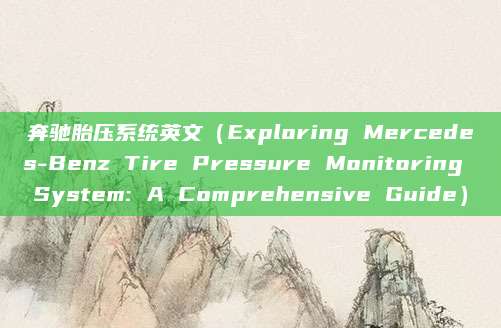Introduction:
The Mercedes-Benz Tire Pressure Monitoring System (TPMS) is an integral part of modern vehicle safety and performance. Designed to ensure optimal tire pressure, this sophisticated system not only enhances the driving experience but also plays a crucial role in maintaining the longevity of the tires. In this article, we delve into the workings of the Mercedes-Benz TPMS and its associated terms to provide a comprehensive understanding of this vital technology.
The Basics of Mercedes-Benz TPMS:
The Mercedes-Benz Tire Pressure Monitoring System is an advanced safety feature that continuously monitors the tire pressure of each wheel. This system uses sensors installed in the tire valves to send real-time data to the vehicle's onboard computer. If a tire's pressure drops below a certain threshold, the driver is immediately notified through the vehicle's display, allowing for timely intervention and preventing potential accidents.

Key Components of Mercedes-Benz TPMS:
1、Tire Pressure Sensors: These sensors are placed within the tire valves and are designed to detect any changes in tire pressure. They use radio signals to communicate with the vehicle's onboard computer.
2、Onboard Computer: The onboard computer processes the data received from the tire pressure sensors and determines if the tire pressure is within the acceptable range.
3、TPMS Indicator: The TPMS indicator is a warning light displayed on the vehicle's dashboard. If the tire pressure is low or there is an issue with the TPMS, this light will illuminate.
4、TPMS Service Indicator: After a tire has been replaced or the tire pressure has been adjusted, the TPMS service indicator may come on. This serves as a reminder to the driver to have the TPMS relearned, ensuring the system operates correctly.
Understanding TPMS Terminology:
1、TPMS Relearn: When a tire has been replaced or the tire pressure has been adjusted, the TPMS needs to be relearned. This process involves using a scan tool to reset the tire pressure sensor IDs within the vehicle's onboard computer.
2、TPMS Calibration: Calibration is the process of aligning the tire pressure sensor readings with the vehicle's wheel positions. This is typically done using a scan tool and can be necessary after certain tire-related services.
3、TPMS Error Codes: If the TPMS detects an issue, it will trigger an error code. These codes can be read using a scan tool and help diagnose the specific problem with the TPMS.
4、TPMS Sensor Replacement: In some cases, a TPMS sensor may need to be replaced if it becomes faulty or damaged. This process involves removing the old sensor and installing a new one.
Benefits of Mercedes-Benz TPMS:
1、Improved Safety: By monitoring tire pressure, the Mercedes-Benz TPMS helps prevent tire-related accidents, such as blowouts or loss of control.
2、Enhanced Performance: Proper tire pressure ensures optimal vehicle performance, including better handling, acceleration, and fuel efficiency.
3、Extended Tire Life: Maintaining correct tire pressure can significantly increase the lifespan of your tires, saving you money on replacements.
Conclusion:
The Mercedes-Benz Tire Pressure Monitoring System is a vital component of modern vehicle safety and performance. By continuously monitoring tire pressure, this system helps prevent accidents, enhance driving experience, and extend tire life. Understanding the key components, terminology, and benefits of the TPMS can help drivers make informed decisions about their vehicles' maintenance and ensure optimal performance and safety on the road.









